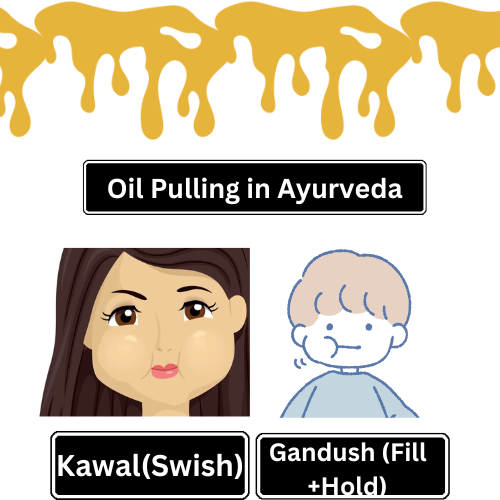Introduction:
Oil pulling, also known as “Kavala” or “Gandusha” in Ayurveda, is a powerful practice aimed at promoting oral health and overall detoxification. By swishing oil, such as coconut or sesame oil, in your mouth for 15-20 minutes on an empty stomach, you can effectively engage in oil pulling to remove toxins (referred to as ama in Ayurveda), reduce plaque, combat bad breath, and improve gum health.
Research indicates that oil pulling can significantly reduce bacteria in the mouth, which is beneficial for preventing gingivitis and reducing inflammation. Oils like coconut oil, rich in lauric acid, exhibit strong antibacterial properties, while sesame oil is traditionally favored for its therapeutic effects. Regular practice of oil pulling not only enhances oral hygiene but may also contribute to overall health by detoxifying the body.
For the best results, choose oils like coconut oil for its antibacterial benefits or sesame oil, which Ayurveda recommends due to its anti-inflammatory properties. You can also explore other oils, such as neem oil, which is highly effective in treating gum infections and reducing plaque.

The Benefits of Oil Pulling in Ayurveda
Ayurvedic oil pulling offers a wide range of health benefits. From reducing harmful bacteria in the mouth to promoting healthier gums, this practice has been known to:
- Strengthen teeth and gums
- Reduce bad breath
- Prevent cavities and tooth decay
- Alleviate dry mouth and throat
- Support overall detoxification of the body
Regular oil pulling helps remove “Ama” (toxins) from the mouth, which is the root cause of various diseases in Ayurvedic philosophy.
Types of Oils for Oil Pulling
The effectiveness of oil pulling depends on the type of oil used. Ayurveda suggests several oils, each with unique benefits for oral and overall health:
- Coconut Oil: Known for its antimicrobial properties, coconut oil is often used for oil pulling. Its lauric acid content helps fight bacteria and reduce inflammation.
- Sesame Oil: Traditionally the most commonly used oil in Ayurveda, sesame oil is rich in antioxidants and helps balance the three doshas (Vata, Pitta, Kapha).
- Black Seed Oil: A lesser-known but powerful option, black seed oil is highly beneficial for its anti-inflammatory and immune-boosting properties. It can help improve oral health by reducing plaque and gingivitis.
By swishing these oils in the mouth for 10–20 minutes, one can achieve both short-term and long-term health benefits.
How to Perform Oil Pulling
Performing oil pulling is simple and can be easily incorporated into your daily Ayurvedic routine:
- Start with an empty stomach. Ideally, perform oil pulling first thing in the morning.
- Take a tablespoon of oil (e.g., coconut, sesame, or black seed oil).
- Swish the oil in your mouth for 15-20 minutes, ensuring it reaches all areas of your mouth.
- Spit out the oil in a trash bin (not the sink, as oil can clog drains).
- Rinse your mouth with warm water and brush your teeth as usual.
This simple practice can be part of your daily routine for long-lasting oral health benefits.
Conclusion
Oil pulling in Ayurveda is a simple yet powerful method for maintaining oral health and overall wellness. By using different types of oils, like coconut, sesame, or black seed oil, individuals can experience a range of benefits, from detoxification to the prevention of gum disease. If you’re looking to improve your oral care routine naturally, oil pulling might be the perfect solution for you.
For more insights into holistic Ayurvedic practices, check out our Ayurveda blog for related articles on balancing the doshas and natural remedies. For further reading, this external guide offers more on the science behind oil pulling.
